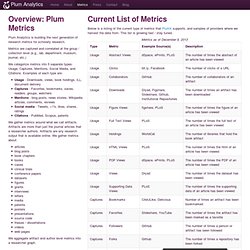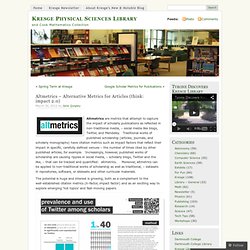

A manifesto – altmetrics.org. Total-impact: uncover the invisible impact of reseach. Altmetrics for Librarians: Pros and Cons. While digital libraries, institutional repositories, journals and databases provide an open opportunity to download scholarly research, “alternative metrics” or altmetrics supply usage statistics, which can be very useful in determining an article’s popularity and its reading potential.[1] “We may be witnessing a tipping point in collaboration, faster access, and new opportunities.”[2] Almetrics allows librarians to provide their users with statistics regarding academic articles more quickly.

Altmetrics can tell us how many times an article, website, software or blog has been viewed, downloaded, reused, shared, and cited.[3] It has been noted that there is correlation between the number of online views and downloads of an article and the number of times that article will be cited in future research.[4] The pros of altmetrics. Plum Analytics. Plum Analytics is building the next generation of research metrics for scholarly research.

Metrics are captured and correlated at the group / collection level (e.g., lab, department, museum, journal, etc.) We categorize metrics into 5 separate types: Usage, Captures, Mentions, Social Media, and Citations. Examples of each type are: Usage - Downloads, views, book holdings, ILL, document delivery Captures - Favorites, bookmarks, saves, readers, groups, watchers Mentions - blog posts, news stories, Wikipedia articles, comments, reviews Social media - Tweets, +1's, likes, shares, ratings Citations - PubMed, Scopus, patents We gather metrics around what we call artifacts.
Altmetrics – Alternative Metrics for Articles (think: impact 2.0) « Kresge Physical Sciences Library. March 30, 2012 by Jane Quigley Altmetrics are metrics that attempt to capture the impact of scholarly publications as reflected in non-traditional media, – social media like blogs, Twitter, and Mendeley.

Traditional works of published scholarship (articles, journals, and scholarly monographs) have citation metrics such as impact factors that reflect their impact in specific, carefully defined venues – the number of times cited by other published articles, for example. Increasingly, however, published works of scholarship are causing ripples in social media, – scholarly blogs, Twitter and the like, – that can be tracked and quantified: altmetrics.
Moreover, altmetrics can be applied to non-traditional works of scholarship as well as traditional, – datasets in repositories, software, or slidesets and other curricular materials.